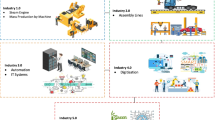Abstract
Technological opportunities and threats relevant to a manufacturing company have to be identified prematurely to derive purposeful measures regarding the future use of a technology in the production environment. However, the identification of technologies is resource-intensive since companies are often unable to specify their prospective technology needs. This paper therefore presents an applicable method to support producing companies in specifying technology needs. The method consists of three steps that focus on deriving, selecting and describing relevant search fields constituting those needs. Thus, technologies covering the defined needs that may represent a technological opportunity or threat for a company can be found more effectively. The method has been applied at a German automobile manufacturer.







Similar content being viewed by others
References
Zäh M, Reinhart G, Karl F, Schindler S, Pohl J, Rimpau C (2010) Cyclic influences within the production resource planning process. Prod Eng Res Dev 4(4):309–317
Wiendahl HP, ElMaraghy HA, Nyhuis P, Zäh MF, Wiendahl HH, Duffie N, Kolakowski M (2007) Changeable manufacturing—classification, design and operation. Ann CIRP 56(2):1–25
Wellensiek M, Schuh G, Hacker PA, Saxler J (2011) Technologiefrüherkennung. In: Schuh G, Klappert S (eds) Technologiemanagement. Springer, Berlin, pp 89–169
Tschirky H (1994) The role of technology forecasting and assessment in technology management. R&D Manag 24(2):121–129
Phaal R, Paterson CJ, Probert DR (1998) Technology management in manufacturing business: process and practical assessment. Technovation 18(8):541–589
Gerhard D, Voigt KI (2009) Technology intelligence systems for manufacturing technologies—an empirical analysis in the context of timing-strategies. Int J Technol Mark 3(4):268–287
Reinhart G, Schindler S, Krebs P (2011) Strategic evaluation of manufacturing technologies. In: Hesselbach J, Herrmann C (eds) Glocalized solutions for sustainability in manufacturing. Springer, Berlin, pp 179–184
Savioz P (2004) Technology intelligence: concept design and implementation in technology based SMEs. Palgrave Macmillan, Houndmills
Ashton WB, Stacey GS (1995) Technical intelligence in business: understanding technology threats and opportunities. Int J Technol Manag 10(1):79–104
Reger G (2001) Technology foresight in companies: from an indicator to a network and process perspective. Technol Anal Strateg Manag 13(4):533–553
Lichtenthaler E (2002) Organisation der Technology Intelligence: Eine empirische Untersuchung der Technologiefrühaufklärung in technologieintensiven Grossunternehmen. Verlag Industrielle Organisation, Zürich
Cetindamar D, Phaal R, Probert D (2009) Understanding technology management as a dynamic capability: a framework for technology management activities. Technovation 29(4):237–246
Kerr C, Mortara L, Phaal R, Probert D (2006) A conceptual model for technology intelligence. Int J Technol Intell Plan 2(1):73–93
Lichtenthaler E (2003) Third generation management of technology intelligence processes. R&D Manag 33(4):361–375
Mortara L, Kerr CIV, Phaal R, Probert D (2009) Technology Intelligence practice in UK technology-based companies. Int J Technol Manag 48(1):115–135
Ashton WB, Kinzey BR, Gunn M Jr (1991) A structured approach for monitoring science and technology developments. Int J Technol Manag 6(1–2):91–111
Rohrbeck R (2006) Technology scouting—harnessing a network of experts for competitive advantage. In: Proceedings of the 4th seminar on project and innovation, 28–29 August 2006, Turku, Finnland
Greitemann J, Worbs A, Hehl M, Schönmann A, Reinhart G (2015) Technologieidentifikation - Methodik und Evaluation. Zeitschrift für wirtschaftlichen Fabrikbetrieb (ZWF) 110(10):630–634
Peiffer S (1992) Technologie-Frühaufklärung: Identifikation und Bewertung zukünftiger Technologien in der strategischen Unternehmensplanung. S+W Steuer- und Wirtschaftsverlag, Hamburg
Gassmann O, Kausch C (2005) Den Technologietrend nicht verschlafen - Strategische Unternehmensführung mit Suchfeldanalyse. Wissenschaftsmanagement: Zeitschrift für Innovation 2(3–4):25–30
Lizaso F, Reger G (2004) Scenario-based roadmapping: a conceptual view. In: EU-US Seminar: new technpology foresight, forecasting and assessment methods, 13–14 May 2004, Seville
Schuh G, Grawatsch M (2003) Triz-based technology intelligence. In: European TRIZ Association meeting TRIZ Futures, 12–14 November 2003, Aachen
Vollmer M, Schmitz M, Warschat J (2013) How function analysis of manufacturing processes can stimulate technology intelligence processes. In: Proceedings of the PICMET’13 conference, 28 July–01 August 2013, San Jose, USA
Balachandra R (1980) Technological forecasting: who does it and how useful is it? Technol Forecast Soc Chang 16(1):75–85
Balachandra R (1980) Perceived usefulness of technological forecasting techniques. Technol Forecast Soc Chang 16(2):155–166
Greitemann J, Stahl B, Schoenmann A, Lohmann B, Reinhart G (2015) Strategic production technology planning using a dynamic technology chain calendar. Prod Eng Res Dev 9(3):417–424
Gausemeier J, Fink A, Schlake O (1998) Scenario management: an approach to develop future potentials. Technol Forecast Soc Chang 59(2):111–130
Klocke F, Fallböhmer M, Kopner A, Trommer G (2000) Methods and tools supporting modular process design. Robot Comput Integr Manuf 16(6):411–423
Greitemann J, Plehn C, Koch J, Reinhart G (2014) Strategic screening of manufacturing technologies. In: Zaeh MF (ed) Enabling manufacturing competitiveness and economic sustainability. Springer, Berlin, pp 321–326
Saaty TL (1990) The analytic hierarchy process: planning, priority setting, resource allocation, 2nd edn. RWS Publishing, Pittsburgh
Gruber TR (1993) A translation approach to portable ontology specifications. Knowl Acquis 5(2):199–220
Kitamura Y, Mizoguchi R (2003) Ontology-based description of functional design knowledge and its use in a functional way server. Expert Syst Appl 24(2):153–166
Schimpf S (2010) Social software-supported technology monitoring for custom-built products. Dissertation, Universität Stuttgart, IPA-IAO Forschung und Praxis, Band 494. Jost-Jetter, Heimsheim
Acknowledgments
The German Research Foundation (DFG) funds this research and development project. We extend our sincere thanks to the DFG for the generous support of the work described in this paper, resulting from the subproject B3 of the second funding phase in the framework of the Collaborative Research Centre 768 “Managing cycles in innovation processes”. The goal of the Collaborative Research Centre 768 is to reduce the knowledge gap regarding cycles and cyclic influences within the innovation process.
Author information
Authors and Affiliations
Corresponding author
Rights and permissions
About this article
Cite this article
Greitemann, J., Hehl, M., Wagner, D. et al. Scenario and roadmap-based approach for the analysis of prospective production technology needs. Prod. Eng. Res. Devel. 10, 337–343 (2016). https://doi.org/10.1007/s11740-016-0675-6
Received:
Accepted:
Published:
Issue Date:
DOI: https://doi.org/10.1007/s11740-016-0675-6




